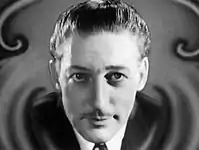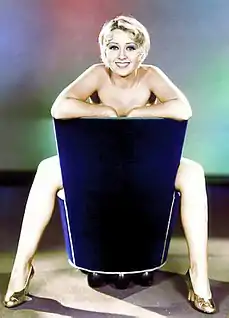Three on a Match
Three on a Match is a 1932 American pre-Code crime drama released by Warner Bros. The film was directed by Mervyn LeRoy and stars Joan Blondell, Warren William, Ann Dvorak and Bette Davis. The film also features Lyle Talbot, Humphrey Bogart, Allen Jenkins and Edward Arnold.[1]
| Three on a Match (1932) | |
|---|---|
 Theatrical release poster | |
| Directed by | Mervyn LeRoy |
| Produced by | |
| Screenplay by | Lucien Hubbard |
| Story by | |
| Starring | |
| Music by | Leo F. Forbstein Ray Heindorf |
| Cinematography | Sol Polito |
| Edited by | Ray Curtiss |
Production company | |
| Distributed by | Warner Bros. |
Release date |
|
Running time | 63 mins. |
| Country | United States |
| Language | English |
Plot
Three women who went to the same elementary school, Mary (Joan Blondell), Ruth (Bette Davis), and Vivian (Ann Dvorak), meet again as young adults after some time apart. They each light a cigarette from the same match and discuss the superstition that such an act is unlucky and that Vivian, the last to light her cigarette, will be the first to die.
Mary is a show girl who has established stability in her life after spending some time in a reform school, while Ruth works as a stenographer. Vivian is the best off of the three, married to successful lawyer Robert Kirkwood (Warren William) and with a young son Robert Jr. (Buster Phelps), but she has grown dissatisfied with her life. Just before she's about to leave for Europe on an ocean liner with her son, Mary comes along with two men going to some friends' bon voyage party aboard the ship before it sails. Gambler Michael Loftus (Lyle Talbot), one of the two men, flirts with Vivian. She's smitten with him and he persuades her to run away with him. Before the ship sets sail, she gathers up her son and the three disembark from the boat.
Vivian and Michael Loftus live a very shabby life, so that Mary, concerned about Vivian's neglect of her son, tells Robert (nearly mad about the disappearance of his son) where to find the boy. Mary and Ruth are very fond of Junior so that Robert proposes to Mary and hires Ruth to look after the child. Mary and Robert marry the same day his divorce from Vivian becomes final.
Meanwhile, Vivian has become a hopeless drug addict and spends all of her money. Additionly, Michael owes $2,000 to gangster Ace (Edward Arnold), who tells him to pay up or else. Desperate, Michael tries to blackmail Robert by threatening to inform the press about Mary's criminal background. When that does not work (as Robert is already aware of Mary's checkered past), the gangsters force him into kidnapping Robert's son so that they can collect the ransom in lieu of payment.
One of the gangsters, while out trying to score a fix for Vivian, sees policemen going door to door searching for the kidnapped boy. He returns to the apartment and informs the gang that the cops will be there shortly. The gangsters decide they have no choice but to kill the child and get rid of his body before the police arrive and catch them red-handed with the evidence (i.e.,the boy). Michael balks at the plan. Vivian overhears the dastardly plot and is determined to save her son's life at all costs. Shaking with fear, she scrawls a message in lipstick on her nightgown that relays the boy's whereabouts, then she throws herself out of the fourth-floor window, killing herself, but leading to the child's rescue.
Cast
- Virginia Davis as Mary Keaton as a child
- Joan Blondell as Mary Keaton / Mary Bernard
- Anne Shirley (credited as Dawn O'Day) as Vivian Revere as a child
- Ann Dvorak as Vivian Revere Kirkwood
- Betty Carse as Ruth Westcott as a child
- Bette Davis as Ruth Westcott
- Warren William as Robert Kirkwood
- Lyle Talbot as Michael Loftus
- Humphrey Bogart as Harve
- Allen Jenkins as Dick
- Edward Arnold as Ace
- Frankie Darro as Bobby
- Glenda Farrell as Mrs. Black
- Buster Phelps as Robert Jr.
- Grant Mitchell as Mr. Gilmore, school principal
- Principal cast members, from the trailer
 Blondell
Blondell William
William Dvorak
Dvorak Davis
Davis
Production
Dvorak was the last of the four principal actors to be cast.[2] This was Bogart's first appearance as a hoodlum type, although his work in Midnight (released 1934) preceded this role and led to his being cast by LeRoy.[3]
Filming took place in June 1932.[4]
When this film was released in October 1932, the Lindbergh kidnapping was very much in the news and the kidnappers had not yet been caught. The kidnapping of a child in the story raised concerns with censors, but Jason Joy of the Studio Relations Committee[lower-alpha 1] successfully made a case for the film to the censors in New York, Ohio, Pennsylvania and Maryland.[5]

Promotion
Joan Blondell posed for a risqué 1932 promotional publicity photo for the film which was later banned under the Motion Picture Production Code.
Reception
Three on a Match received tepid to poor notices overall.[4][6] Mordaunt Hall of the New York Times called Three on a Match "tedious and distasteful" as well as "unintelligent".[7] The Time reviewer felt the film did not carry much weight, unlike previous Glasmon–Bright productions,[lower-alpha 2] and that the suicide at the end was more implausible than tragic.[8] Kaspar Monahan of the Pittsburgh Press thought that it began with the hope of being "different" but ultimately devolved into a "gangster yarn" and summarized: "Direction good for the most part; acting as good as can be expected under the circumstances; story erratic."[9]
The Spokane Spokesman-Review expressed admiration for the way the passage of time is shown through several montage sequences, calling it "a brand new approach and treatment ..." and commented that the film "rang true".[10]
Trade paper reviews advised exhibitors to focus on the cast: "An attractive cast array is the attendance motive for this picture which is surprising in its meager demands upon its quartet of featured people" was the opening comment of Variety's Sid Silverman.[11] The Film Daily review, too, said the "cast helps" with a plot that has "too many turns".[12] The Motion Picture Herald also advised exhibitors to focus on the "strength of the cast names" and not to even use the word "kidnaping" or allude to it in promotions.[13]
Decades after its release, the film found more favor with critics and film historians. In 1969, William K. Everson called it "unusually carefully-made" and wrote, "Splendidly cut and paced ... and climaxed by a real shocker, Three on a Match is still a vivid little picture".[14] Wheeler Winston Dixon observed, "the film is astonishing for the amount of information that LeRoy manages to compress into this lightning fast tale".[15] It has been pointed to as Dvorak's best performance for Warners.[16]
Leonard Maltin gives the film three out of four stars, describing it as a “Fine, fast-moving (and surprisingly potent) pre-Code melodrama of three girls who renew childhood friendship, only to find suspense and tragedy. Dvorak is simply marvelous.”[17]
In 1938 Warner Bros. released Broadway Musketeers, a remake of Three on a Match.[18]
References
Informational notes
- The arm of the Motion Picture Producers and Distributors of America tasked with implementing the Hays Code
- e.g., The Public Enemy (1931)
Citations
- "Three on a Match]". Turner Classic Movies. Atlanta: Turner Broadcasting System (Time Warner). Retrieved September 14, 2016.
- Ralph Wilk (May 27, 1932). "A Little from the 'Lots'". The Film Daily. LIX (49): 7. Retrieved October 15, 2015 – via Internet Archive.
- Richard Schickel (2006). Bogie: A Celebration of the Life and Films of Humphrey Bogart. St. Martin's Press. p. 99. ISBN 978-0-312-36629-2.
- Christina Rice (2013). Ann Dvorak: Hollywood's Forgotten Rebel. University Press of Kentucky. pp. 83–84, 88. ISBN 978-0-8131-4440-5.
- Ruth Vasey (1997). The World According to Hollywood, 1918–1939. Univ of Wisconsin Press. p. 110. ISBN 978-0-299-15194-2.
- Jeff Stafford. "Three on a Match (1932)". Turner Classic Movies. Retrieved October 15, 2015.
- Mordaunt Hall (October 29, 1932). "Blackmail and Kidnapping". New York Times. Retrieved October 15, 2015.
- "Cinema: The New Pictures: Nov. 7, 1932", Time. (subscription required)
- Kaspar Monahan (November 4, 1932). "The Show Stops". The Pittsburgh Press. p. 48. Retrieved October 15, 2015.
- "Ann Dvorak Star in Film at Fox". The Spokesman-Review. November 17, 1932. p. 5. Retrieved October 15, 2015.
- Sid Silverman (November 1, 1932). "Three on a Match". Film Reviews. Variety. 108 (8): 12. Retrieved October 17, 2015 – via Internet Archive.
- "Three on a Match". The Film Daily. LX (102): 6. October 29, 1932. Retrieved October 17, 2015 – via Internet Archive.
- "Three on a Match". Showmen's Reviews. Motion Picture Herald. 109 (1): 52–53. October 1, 1932. Retrieved October 17, 2015 – via Internet Archive.
- William K. Everson (February 21, 1969). "Program Notes: 'Three on a Match'" (PDF). William K. Everson Archive. New York University. Retrieved October 18, 2015.
- Wheeler Winston Dixon (2013). "Precursors to Film Noir". In Andre Spicer; Helen Hanson (eds.). A Companion to Film Noir. John Wiley & Sons. p. 100. ISBN 978-1-118-52371-1.
- Ray Hagen; Laura Wagner (2004). Killer Tomatoes: Fifteen Tough Film Dames. McFarland. p. 54. ISBN 978-0-7864-8073-9.
- "Three on a Match (1932) - Overview - TCM.com". Turner Classic Movies. Retrieved June 13, 2020.
- "Broadway Musketeers". Catalog of Feature Films. American Film Institute. Retrieved October 17, 2015.
External links
| Wikimedia Commons has media related to Three on a Match. |